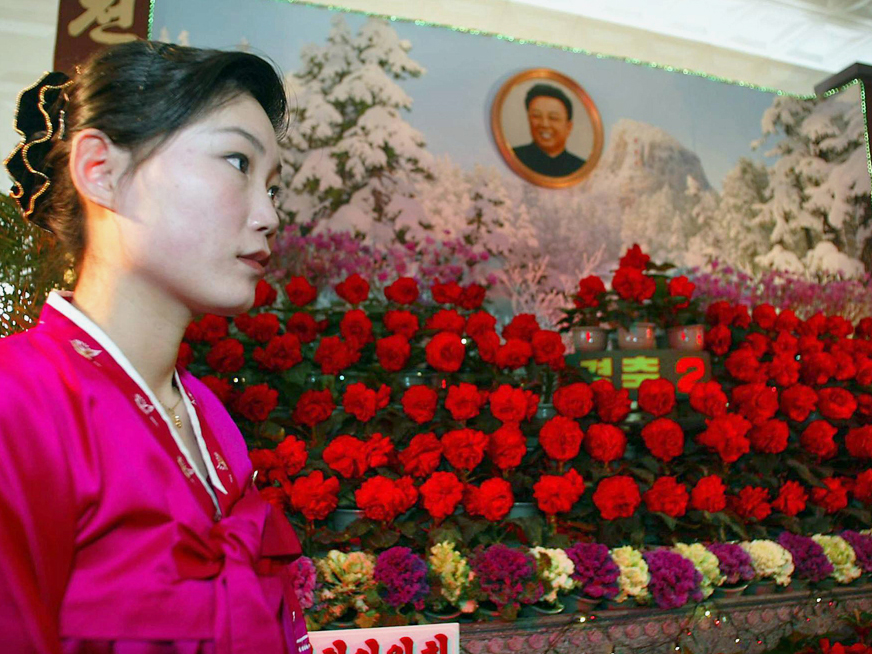

Around 700,000 people are expected to cram into the exhibition hall in Pyongyang over seven days, and its passages were packed on Friday as soldiers and civilians made their way past the displays, many in jovial mood
Sebastien Berger -
A humble two-room hut nestles beneath snow-laden trees, a warm red glow emerging from within, reminiscent of a Christmas Nativity.
It is, according to North Korean orthodoxy, the mountainside birthplace of Kim Jong-Il, who inherited power from his father and
passed it in turn to his son, current leader Kim Jong-Un.
The image of the Day of the Shining Star, as the occasion is known, is a recurring motif at the Kimjongilia flower festival in Pyongyang, appearing in mosaics and models surrounded by the eponymous red blooms.
Guide Ri Yun-I had no doubts. “The great leader general Kim Jong-Il was born in a secret camp on Mount Paektu,” she said — a volcano straddling the Chinese-Korean border seen as the spiritual birthplace of the Korean nation.
Such origins would be appropriate for a man destined to lead the Democratic People’s Republic of Korea, as the North is officially known.
“Our great general Kim Jong-Il devoted his whole life only for the prosperity of the country and our people’s happiness,” said Ri. “Our people strongly miss him.”
But outsiders beg to differ, pointing instead to Soviet records putting his place of birth as a Siberian village where his father was in exile, and a year earlier than Pyongyang’s 1942.
Officially, it is 75 years since Kim Jong-Il was born, and the North is marking the anniversary with skating and synchronised swimming shows, fireworks and the flower festival — with no mention of the killing this week in Malaysia of Kim Jong-Nam, his first-born son and Kim Jong-Un’s half-brother.
Around 700,000 people are expected to cram into the exhibition hall in Pyongyang over seven days, and its passages were packed on Friday as soldiers and civilians made their way past the displays, many in jovial mood.
The Kimjongilia, a large begonia, was the unquestioned dominant feature, with 100,000 potted blooms on show.
Each stand was supplied by a different organisation or individual, ranging from the North’s central bank — whose stand featured a red map of a unified Korea, decked out in lights — to an 11-year-old schoolboy.
Two stands held flowers presented in the names of overseas “friendship and solidarity” organisations or foreign embassies and leaders, with pride of place given to the President of the Syrian Arab Republic and the general secretary of the central committee of the Lao Peoples Revolutionary Party.
“Our people cultivate very many Kimjongilias greeting the birthday of the great general Kim Jong-Il,” explained Ri.
The flower was bred by Japanese botanist Kamo Mototeru, who Ri said “visited our country several times and he witnessed the reality of our country”.
As a result he “admired the brilliance of General Kim Jong-Il” and so presented him with his creation.
His father Kim Il-Sung had previously been honoured in 1965 with the Kimsungilia, a purple orchid named after him by Indonesian leader Sukarno.
Kim Jong-Il died in 2011 and regular visitor Kim Nam-Hui said that he was “someone we all follow like our father and miss so much”.
In the 29-year-old teacher’s opinion, the Kimjongilia is “the most beautiful flower in the world”.
But, she said, “We come to this flower festival out of our longing for the general Kim Jong-Il and the longing for our nation, rather than because of the beauty of flowers.” — AFP
Oman Observer is now on the WhatsApp channel. Click here



